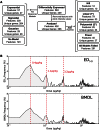2,3,7,8-Tetrachlorodibenzo-p-Dioxin Alters Lipid Metabolism and Depletes Immune Cell Populations in the Jejunum of C57BL/6 Mice
- PMID: 26377647
- PMCID: PMC5009443
- DOI: 10.1093/toxsci/kfv206
2,3,7,8-Tetrachlorodibenzo-p-Dioxin Alters Lipid Metabolism and Depletes Immune Cell Populations in the Jejunum of C57BL/6 Mice
Abstract
2,3,7,8-Tetrachlorodibenzo-p-dioxin (TCDD) is a potent aryl hydrocarbon receptor agonist that elicits dose-dependent hepatic fat accumulation and inflammation that can progress to steatohepatitis. To investigate intestine-liver interactions that contribute to TCDD-elicited steatohepatitis, we examined the dose-dependent effects of TCDD (0.01, 0.03, 0.1, 0.3, 1, 3, 10, or 30 µg/kg) on jejunal epithelial gene expression in C57BL/6 mice orally gavaged every 4 days for 28 days. Agilent 4x44K whole-genome microarray analysis of the jejunal epithelium identified 439 differentially expressed genes (|fold change| ≥ 1.5, P1(t) ≥ 0.999) across 1 or more doses, many related to lipid metabolism and immune system processes. TCDD-elicited differentially expressed genes were associated with lipolysis, fatty acid/cholesterol absorption and transport, the Kennedy pathway, and retinol metabolism, consistent with increased hepatic fat accumulation. Moreover, several major histocompatibility complex (MHC) class II genes (H2-Aa, H2-Ab1, H2-DMb1, Cd74) were repressed, coincident with decreased macrophage and dendritic cell levels in the lamina propria, suggesting migration of antigen-presenting cells out of the intestine. In contrast, hepatic RNA-Seq analysis identified increased expression of MHC class II genes, as well as chemokines and chemokine receptors involved in macrophage recruitment (Ccr1, Ccr5, Ccl5, Cx3cr1), consistent with hepatic F4/80 labeling and macrophage infiltration into the liver. Collectively, these results suggest TCDD elicits changes that support hepatic lipid accumulation, macrophage migration, and the progression of hepatic steatosis to steatohepatitis.
Keywords: MetS; NAFLD; TCDD; jejunum; macrophage; toxicogenomics.
© The Author 2015. Published by Oxford University Press on behalf of the Society of Toxicology. All rights reserved. For Permissions, please e-mail: journals.permissions@oup.com.
Figures






Similar articles
-
Aryl Hydrocarbon Receptor (AhR) Activation by 2,3,7,8-Tetrachlorodibenzo-p-Dioxin (TCDD) Dose-Dependently Shifts the Gut Microbiome Consistent with the Progression of Non-Alcoholic Fatty Liver Disease.Int J Mol Sci. 2021 Nov 18;22(22):12431. doi: 10.3390/ijms222212431. Int J Mol Sci. 2021. PMID: 34830313 Free PMC article.
-
Dose-Dependent Metabolic Reprogramming and Differential Gene Expression in TCDD-Elicited Hepatic Fibrosis.Toxicol Sci. 2016 Dec;154(2):253-266. doi: 10.1093/toxsci/kfw163. Epub 2016 Aug 25. Toxicol Sci. 2016. PMID: 27562557 Free PMC article.
-
2,3,7,8-Tetrachlorodibenzo-p-dioxin (TCDD) alters hepatic polyunsaturated fatty acid metabolism and eicosanoid biosynthesis in female Sprague-Dawley rats.Toxicol Appl Pharmacol. 2020 Jul 1;398:115034. doi: 10.1016/j.taap.2020.115034. Epub 2020 May 5. Toxicol Appl Pharmacol. 2020. PMID: 32387183 Free PMC article.
-
Cell-specific AHR-driven differential gene expression in the mouse liver cell following acute TCDD exposure.BMC Genomics. 2024 Aug 28;25(1):809. doi: 10.1186/s12864-024-10730-3. BMC Genomics. 2024. PMID: 39198768 Free PMC article.
-
Comparative toxicogenomic examination of the hepatic effects of PCB126 and TCDD in immature, ovariectomized C57BL/6 mice.Toxicol Sci. 2008 Mar;102(1):61-75. doi: 10.1093/toxsci/kfm289. Epub 2007 Nov 27. Toxicol Sci. 2008. PMID: 18042819
Cited by
-
Xanthohumol Effect on 2,3,7,8-Tetrachlorodibenzo-p-dioxin-Treated Japanese Quails in Terms of Serum Lipids, Liver Enzymes, Estradiol, and Thyroid Hormones.ACS Omega. 2020 Sep 18;5(38):24445-24452. doi: 10.1021/acsomega.0c02896. eCollection 2020 Sep 29. ACS Omega. 2020. PMID: 33015460 Free PMC article.
-
From the Cover: Coagulation-Driven Hepatic Fibrosis Requires Protease Activated Receptor-1 (PAR-1) in a Mouse Model of TCDD-Elicited Steatohepatitis.Toxicol Sci. 2016 Dec;154(2):381-391. doi: 10.1093/toxsci/kfw175. Epub 2016 Sep 9. Toxicol Sci. 2016. PMID: 27613713 Free PMC article.
-
Aryl Hydrocarbon Receptor (AhR) Activation by 2,3,7,8-Tetrachlorodibenzo-p-Dioxin (TCDD) Dose-Dependently Shifts the Gut Microbiome Consistent with the Progression of Non-Alcoholic Fatty Liver Disease.Int J Mol Sci. 2021 Nov 18;22(22):12431. doi: 10.3390/ijms222212431. Int J Mol Sci. 2021. PMID: 34830313 Free PMC article.
-
Boron Compounds Mitigate 2,3,7,8-Tetrachlorodibenzo-p-dioxin-Induced Toxicity in Human Peripheral Blood Mononuclear Cells.Toxics. 2024 Jan 23;12(2):98. doi: 10.3390/toxics12020098. Toxics. 2024. PMID: 38393193 Free PMC article.
-
Flux, Impact, and Fate of Halogenated Xenobiotic Compounds in the Gut.Front Physiol. 2018 Jul 10;9:888. doi: 10.3389/fphys.2018.00888. eCollection 2018. Front Physiol. 2018. PMID: 30042695 Free PMC article. Review.
References
-
- Alberti K. G., Eckel R. H., Grundy S. M., Zimmet P. Z., Cleeman J. I., Donato K. A., Fruchart J. C., James W. P., Loria C. M., Smith S. C., Jr. (2009). Harmonizing the metabolic syndrome: A joint interim statement of the International Diabetes Federation Task Force on Epidemiology and Prevention; National Heart, Lung, and Blood Institute; American Heart Association; World Heart Federation; International Atherosclerosis Society; and International Association for the Study of Obesity. Circulation 120, 1640–1645. - PubMed
-
- Bhat V. S., Hester S. D., Nesnow S., Eastmond D. A. (2013). Concordance of transcriptional and apical benchmark dose levels for conazole-induced liver effects in mice. Toxicol. Sci. 136, 205–215. - PubMed
Publication types
MeSH terms
Substances
Grants and funding
LinkOut - more resources
Full Text Sources
Other Literature Sources
Medical
Molecular Biology Databases
Research Materials

